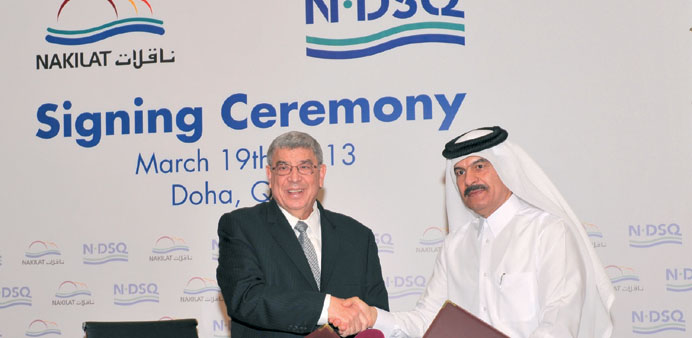|
|
Qatar has entered into the high-profile superyacht new-build market with Nakilat Damen Shipyards Qatar (NDSQ) signing the contract for a 69m-long “fast luxury” vessel to be built entirely in the country.
The customised vessel will be built at the Erhama Bin Jaber Al Jalahma Shipyard at Ras Laffan by NDSQ, the shipbuilding joint venture between Nakilat and Dutch firm Damen Shipyards.
Based on the proven axe-bow hull of Damen’s 67m Sea-Axe navy, coastguard and yacht support vessels, the vessel will be equipped with the latest technology and can reach speeds of up to 20 knots.
The contract was signed by HE Sheikh Mohamed bin Fahd al-Thani, Minister of State, and Mohamed Ghannam, NDSQ chairman at the Intercontinental in Doha yesterday.
Sheikh Mohamed said a superyacht of the category took about three years to complete.
He said: “We are very proud of this great achievement, which represents a key milestone in HH the Emir Sheikh Hamad bin Khalifa al-Thani’s Qatar National Vision 2030. Our fully integrated marine industry will play a major role in the future development of Qatar and we are delighted to be placing this order for the first vessel of this type to be built in Qatar, for Qatar.”
Ghannam thanked Sheikh Mohamed for giving NDSQ the opportunity to build the ultra-luxury vessel and thereby becoming a premier builder of commercial ships and yachts.
Terming the vessel “unique”, Ghannam said it would be equipped with features and facilities, which are unheard of in the global marine industry.
“By building this unique vessel, Nakilat is helping to demonstrate to the marine industry worldwide that Qatar is offering strong competition on the international yacht building market – in terms of quality, price and delivery,” Ghannam said.
He urged Qatar’s marine companies and other institutions, including the Qatar Emiri Naval Forces and the Coasts and Borders Security Department, to “seriously consider” Nakilat when planning the construction of any new vessels for their fleets.
“Nakilat will offer all potential customers high-quality vessels at very competitive prices,” Ghannam said.
In line with HH the Emir’s Qatar National Vision 2030, Nakilat has developed a fully integrated marine industry in Qatar, he said.
Currently, Nakilat can repair all sizes of vessels up to world’s largest LNG carriers, building all types of vessels up to 170m, including coastguard and defence vessels, commercial and offshore vessels, and luxury yachts, and fabricating all types of marine structures.
NDSQ’s facilities at Erhama Bin Jaber Al Jalahma Shipyard include a 180m long x 70m wide x 50m high hall for the finishing and refit of high-value vessels, featuring two separate, fully climate-controlled bays.
“Along with our globally renowned partner, Keppel Offshore & Marine and Damen Shipyards, we are offering state-of-the-art products and providing our customers with first class service that is unsurpassed in terms of safety, reliability and competitiveness,” Ghannam said.
The signing of the fast luxury vessel expands the list of NDSQ’s recent achievements. In January NDSQ inaugurated the 140m barge Al Ghatroushah, the largest vessel ever to have been constructed in Qatar.
NDSQ also launched six built-in-Qatar mooring boats in November 2012 and is working on a further 13 vessels destined for use at Qatar’s Mesaieed Port.
Fleet ‘sufficient to meet LNG exports worldwide’
Nakilat’s existing fleet of 54 LNG vessels is sufficient to meet Qatar’s liquefied natural gas exports worldwide, said company managing director Mohamed Ghannam. “Based on Qatar’s current production of 77mn tonnes per year, we believe it is sufficient to meet the demand. But if Qatar choose to go beyond the 77mn tpy, then we will definitely consider fleet strengthening. Otherwise, we will maintain our fleet strength,” Ghannam told Gulf Times yesterday. Established in 2004 as a joint stock company - owned 50% by its founding shareholders and the remainder with the public, Nakilat has the largest LNG shipping fleet in the world, consisting of some 54 LNG vessels along with four Liquefied Petroleum Gas (LPG) Very Large Gas Carriers (VLGCs).



